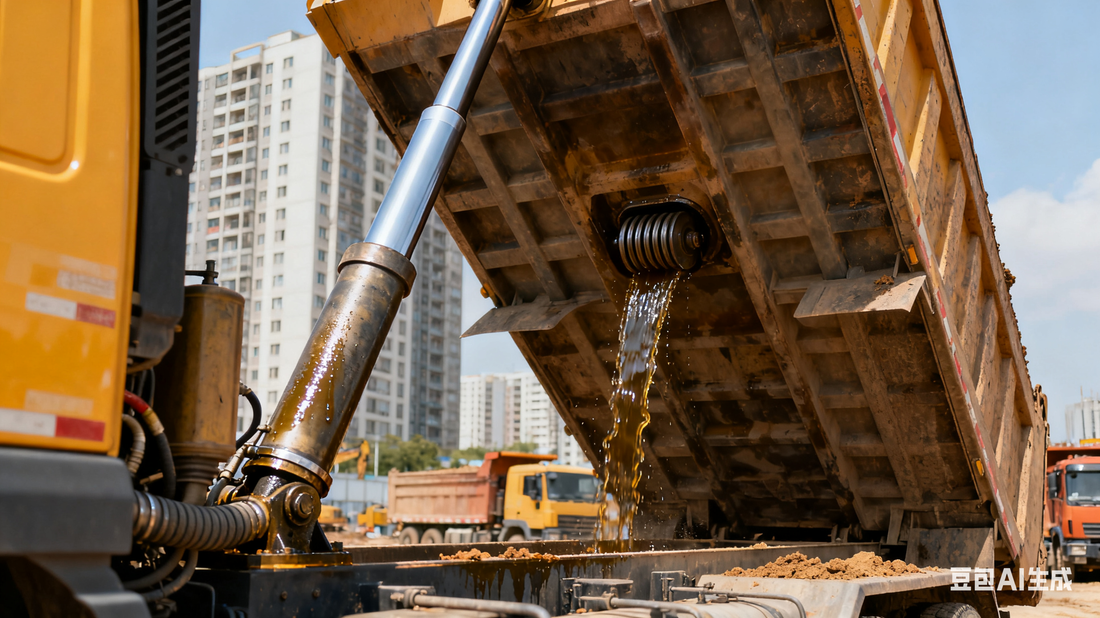
Hidden "Power Core" in Daily Life: Hydraulic Cylinders Drive These Machines Behind the Scenes
Share
When you drive through towns, walk to grab a cup of coffee, or simply glance out the window, there is always a fleet of heavy machinery "working silently" — they keep communities running but are often overlooked. These machines are not just for large-scale projects; they are the "invisible backbone" of daily life in cities and neighborhoods. And the key to their efficient operation is none other than the core component: hydraulic cylinders.
Today, we’ll take a look at 7 types of machinery you encounter almost every day, exploring how they serve daily life and the "power heart" role that hydraulic cylinders play in them.
1. Dump Trucks: Hydraulic Cylinders Make "Unloading" Efficient and Precise
Dump trucks are the "hauling experts" of urban construction. They transport everything from sand and gravel at construction sites, old asphalt from road repairs, to mulch (covering material) for residential greening. And it is exactly hydraulic cylinders that enable the truck bed to lift easily and dump materials with precision.
The strong thrust of hydraulic cylinders can quickly lift heavy truck beds, and the hydraulic system allows for precise control of lifting speed and angle — this not only prevents materials from spilling and polluting the road but also adapts to different unloading scenarios (such as targeted unloading in narrow construction sites). As a hydraulic cylinder factory, we know well: 80% of a dump truck’s operational efficiency depends on the thrust stability and response speed of its cylinders.
2. Garbage Trucks: Hydraulic Cylinders Safeguard the "Rhythm of Urban Cleanliness"
Garbage trucks that show up on time every week are the "guardians" of public health. Whether it’s side-loading garbage trucks in residential areas or front-loading compactors in shopping malls, their core functions — garbage compaction, hopper lifting, and carriage dumping — are all driven by hydraulic cylinders.
Take compacting garbage trucks as an example: Hydraulic cylinders provide continuous and uniform pressure to compress loose garbage into dense blocks, greatly increasing the carriage’s load capacity. When dumping, the cylinders also lift the carriage steadily to ensure all garbage is completely unloaded into landfills. The specialized hydraulic cylinders we produce are also treated for rust and wear resistance to cope with the harsh working conditions of garbage trucks (corrosive sewage, dust), ensuring stable operation of the equipment for years.
3. Forklifts: Hydraulic Cylinders Support the "Flexible Arms of the Supply Chain"
In warehouses and behind the scenes of building material stores (places you don’t usually see), forklifts are busy moving goods on pallets — from fresh produce crates in supermarkets to wardrobes in furniture stores, all rely on forklifts for circulation. And the "lifting power" of forklifts comes entirely from hydraulic cylinders.
The lifting of forklift forks and the tilting of masts all depend on the extension and retraction of hydraulic cylinders: the greater the cylinder thrust, the heavier the goods a forklift can lift; the more precise the cylinder control, the lower the risk of goods tipping over. The hydraulic cylinders we customize for forklifts use high-precision seals, enabling "millimeter-level" lifting control, making supermarket restocking and warehouse inventory management more efficient and safe.
4. Excavators: Hydraulic Cylinders Are the "Soul of Multifunctional Operations"
Whether it’s road construction in cities, sewer digging in residential areas, or foundation building at construction sites — excavators are everywhere. Their ability to dig, shovel, lift, and break all relies on the coordinated work of multiple sets of hydraulic cylinders on their bodies: boom cylinders control the lifting of the machine, arm cylinders adjust the working radius, and bucket cylinders handle material grabbing.
For instance, when repairing a sewer line (sewage pipe), an excavator needs to dig precisely to the pipe’s depth without damaging the surrounding road — this requires hydraulic cylinders to have stable thrust and sensitive feedback. The specialized cylinders we produce for excavators use high-strength alloy barrels, which can withstand impact loads in complex working conditions, making excavation operations fast and accurate.
5. Aerial Work Platforms (Bucket Trucks): Hydraulic Cylinders Ensure "Safe High-Altitude Operations"
Repairing street lamps by the road, emergency maintenance on power lines, or hanging holiday decorations — all these high-altitude tasks depend on bucket trucks. And it is hydraulic cylinders that allow the bucket arm to extend/retract flexibly and position accurately at high-altitude workpoints.
Every movement of a bucket truck — the lifting and rotation of the arm frame, and the fine adjustment of the bucket basket — is driven by hydraulic cylinders. The stable extension/retraction of the cylinders prevents the bucket basket from shaking, ensuring worker safety; the "one-click lowering" function for emergencies also relies on the reliable braking of the cylinders. The hydraulic cylinders we design for aerial work platforms have built-in safety locking devices, which can firmly fix the bucket arm even in case of sudden pressure abnormalities, protecting workers’ lives.
6. Concrete Mixers: Hydraulic Cylinders Prevent "Concrete from Setting"
Building new sidewalks, repairing roads, or constructing new houses — concrete mixers always deliver fresh concrete to the site on time. Their core component, the "rotating mixing drum," is driven to rotate by power from hydraulic cylinders.
The mixing drum needs to rotate continuously at a constant speed to prevent concrete from hardening, and hydraulic cylinders can output stable torque to ensure uniform rotation of the drum. Even when climbing slopes or turning, the cylinders can adjust power adaptively to avoid fluctuations in the drum’s rotation speed. The hydraulic cylinders we produce for concrete mixers have optimized oil circuit designs for heavy-load conditions, ensuring the mixer "keeps rotating non-stop" from the batching plant to the work site.
7. Tow Trucks: Hydraulic Cylinders Solve "Roadside Rescue Problems"
Cars breaking down on highways, illegally parked vehicles blocking roads, or accident vehicles occupying lanes — tow trucks can resolve these issues as soon as they arrive. Whether it’s the platform lifting of flatbed tow trucks or the hook extension of hook-arm tow trucks, all rely on the support of hydraulic cylinders.
For example, flatbed tow trucks need to "lift" faulty vehicles onto their platforms: hydraulic cylinders can provide sufficient thrust to lift the platform steadily. When hook-arm tow trucks hook onto vehicles, the precise extension/retraction of the cylinders can avoid scratching the vehicle body. The hydraulic cylinders we customize for tow trucks use impact-resistant designs, which can ensure structural stability even when towing heavy vehicles, making roadside rescue more efficient.
It Turns Out Hydraulic Cylinders Are the "Invisible Power for Urban Operation"
These machines may seem ordinary, but they are the "cornerstone" of safe, clean, and efficient community operation. And hydraulic cylinders are the "power core" hidden behind them — without stable and reliable cylinders, dump trucks can’t unload, excavators can’t dig, and aerial work platforms can’t lift.
As a factory focusing on hydraulic cylinder production, we have always believed: a good hydraulic cylinder must not only be "powerful" but also "reliable enough" and "precise enough." Because every machine that relies on cylinders is safeguarding our daily lives.
Next time you pass a construction site or see a garbage truck, take a moment to look closer — behind the flexible movements of those machines, it is hydraulic cylinders that are working silently.
